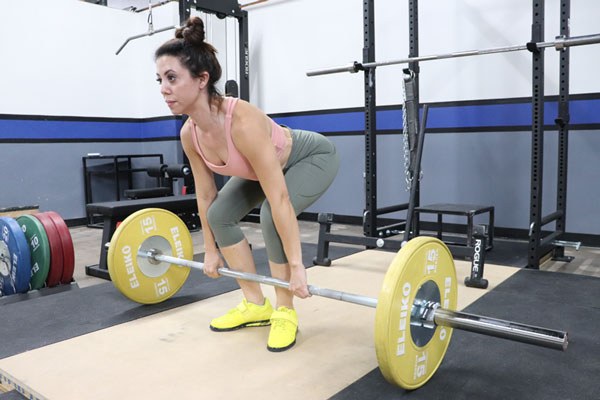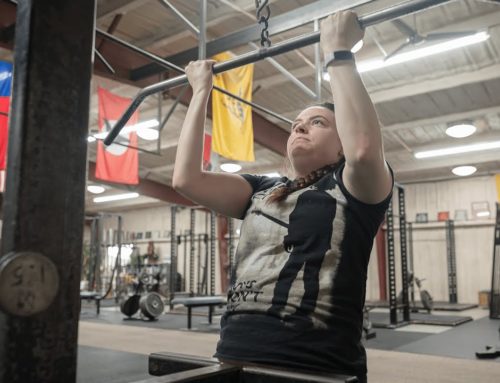The importance of the deadlift cannot be overstated. The deadlift is the most functional barbell exercise we perform because no activity is more common than bending over and picking things up. Doing it incorrectly is one of the most common ways people hurt themselves too. Avoidable back injuries occur as a result of spinal rotation, not actively maintaining spinal position, and not actively engaging the hips while picking up an object. Picking up a box, a desk, a PA speaker, or any large item you find yourself lifting in an awkward position results in a mechanically inefficient movement. In contrast, a barbell is quite ergonomic since it can be picked up off of the floor over the middle of the foot. Overloading a much safer and more mechanically efficient movement, such as the deadlift, minimizes the risk of injury from mechanically inefficient movements performed in our daily lives and reduces the recovery time from those injuries.
Most of us have received the memo, but some missed it. Regardless, I find many lifters who have finished the Starting Strength Novice Linear Progression with a decent squat and a deadlift that is either close to the squat or in some instances lighter. Some of us have small hands, short arms, or a steep motor learning curve (which can be attenuated with coaching). There are certainly outliers, and that is notwho we are discussing.
Ending the Starting Strength novice linear progression with an artificially weak deadlift could be because it was started too light, maybe at the same load as the squat. This may be due to the perception of the difficulty of the lift. Specifically, the novice lifter will almost always perceive the deadlift to be much heavier than it actually is. I recently began filming my coaching sessions so that I can immediately show my clients that what they thought was a 15-second deadlift was in fact a 1-second deadlift. It’s not uncommon for first-time clients to add ~20-50 lb to their 5RM deadlift in a single session.
The reason for the false perception of difficulty is because, unlike the squat, bench press, and the press, the deadlift does not begin with an eccentric muscle action, and must be broken off of the floor from a dead stop. This means that the lifter must first generate isometric force in the back, hamstrings, quadriceps, calves, the arms, and hands prior to lifting the weight. When deadlifting a very light weight this can easily be neglected, and the bar can be immediately pulled off the floor without any effort to set up. However, as the load gets heavier – not necessarily even that close to “1RM heavy” – the initial break off the floor takes slightly longer in real time, but may be perceived to take twice to three times as long.
An analogy is playing tug-of-war: each person grabs one end of the rope and pulls. At a certain point neither person is moving in either direction and much of the applied force is isometric. You would not try to bend and jerk the rope quickly because it’s obvious that you would lose control of the rope to your opponent. You wouldcontinue pulling steadily until you pull the other person away from the starting position. Once appreciable movement occurs it typically gets easier to pull the other side closer. The same can be said of pushing a car: once it’s moving it’s easy to keep pushing versus the initial break from a dead stop.
This same concept applies to the deadlift. Your job is to tug on the bar until it eventually leaves the floor, and then speed up the pull. The squat, in contrast, requires you to descend while the hamstrings stay tight and the glutes, adductors, and quads stretch eccentrically, causing a stretch reflex that leads to a forceful contraction out of the hole. Similarly, the stretching of the pecs, delts, and triceps is followed by a rebound when the bar leaves the chest on a bench press. The quads, abs, delts, and triceps do the same on the press. The deadlift requires you to pull against something that appears not to be moving until it moves, at which point you focus on getting it from point A to point B as fast as possible (which may in fact be slow when the load is actually heavy). This feeling begins at submaximal loads, the first signs of it appearing at loads that can realistically be pulled for 8-10 repetitions. It is a normal part of the lift, and you as the lifter need to become comfortable with it as early as possible.
Some other reasons for an artificially low deadlift are an artifact of what is described above. Since the perception of the lift is that is extremely heavy, the lifter may take timid jumps, repeat loads, and/or reduce the deadlift frequency prematurely. The squat and the deadlift contribute to the majority of muscle acquired from the Starting Strength Linear Progression. Therefore, deadlifts should be progressed three times per week for as long as the lifter can tolerate it. Large (~15-20 lb) load increases should be made in the first week of training, followed by ~10 lb increases for as long as the lifter can tolerate those. The net result is typically a deadlift that is ~50-100 lb ahead of squat 5RM at the end of the novice progression.
This is important, because if the deadlift is artificially light due to an improper progression then what typically happens next is that the squat will eventually get legitimately heavy, taxing the weak low back and resulting in missed deadlifts that would have otherwise been completed. The opposite is not often the case because when the deadlift gets too heavy to recover from it typically will not break off of the floor, even while the squat will continue to progress. Squatting does not require isometric loading to initiate the movement and is more likely to continue making progress in the presence of heavy pulls.
The importance of a big deadlift cannot be overstated. The deadlift is an important contributor to functional strength and muscular bodyweight, and the most important contributor to better aesthetics of all the lifts in the program. The errors described above are important factors to consider as you are going through your own deadlift progression. Go out there and win that game of tug-of-war, a little bit of weight at a time.
A version of this article appeared in Starting Strength 09/10/2019





